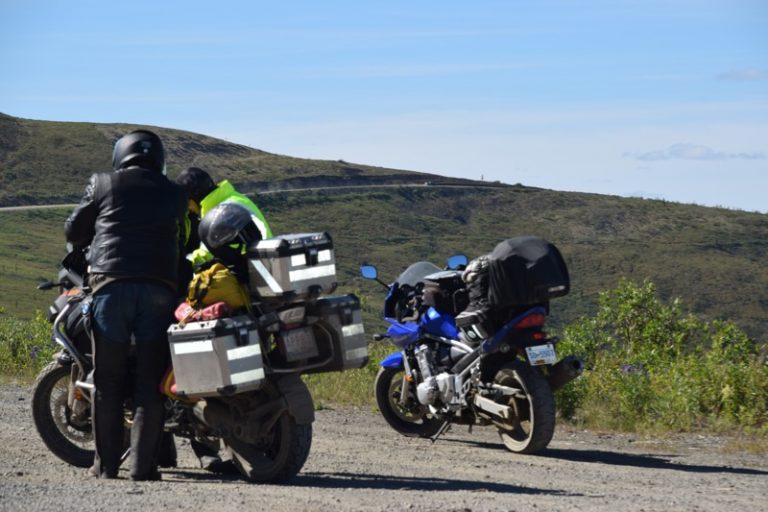Motorcycling in the north is an adventure to remember. Almost every make of motorcycle, in every shape and size, has made the trip through Canada to Alaska. The most common concern expressed by motorcyclists we’ve talked to along the way was the distance between gas stops that can be 100 miles or more on some highways. Many were using The MILEPOST® to figure their gas stops in advance of each day’s travel and most carry extra gas.
Trailers
Many motorcyclists were pulling trailers and there were no significant challenges to report despite driving many miles of road that included stretches of gravel, potholes and frost heaves. We did meet up with a motorcyclist on the Alaska Highway one year who was on the return portion of his trip back to the Lower 48. He had found out the hard way that he was pulling too heavy a trailer for Northern roads. He had had a miserable time negotiating the frost heaves and potholes that plague some roads.
Lighter bikes are more suitable for gravel roads while larger bikes are definitely more comfortable for long highway trips. If you prefer, you can fly or cruise to Alaska then rent a motorcycle out of Anchorage and skip the extra miles and wear on your own bike. Power cruisers and touring bikes are popular choices, especially with those pulling trailers.
Maintenance
Regardless of what you ride, perform major maintenance on your bike before heading North. If you break down on the road, towing distances to the next repair shop can be several hundred miles.
There are motorcycle repair shops in Alaska and Canada, but you will usually find well-stocked motorcycle shops only in the cities. Many riders prefer the comfort designed models made for touring and these are serviced in major cities, just as they are in the Lower 48.
Prep your ride for the road
Windshields are essential to protect riders from gravel and dust. Some bikers also use Plexiglas headlight shields and hand guards. A fairing, while not completely protecting you from rocks, will offer protection against insects, rain, wind and cold. Case guards are good insurance against damage to the bike should you go down. Consider a good competition air filter to improve engine performance and gas mileage. Heated handgrips are also recommended for colder temperatures. A skid plate will help protect the engine from rocks kicked up by the front wheel, and a center stand can be a great help when parking on gravel, fixing a flat or lubing a chain. For additional security, carry a light nylon cover for your bike. Keep your radiator safe from flying rocks with a perforated guard in front of it, as suggested by riders we met on the road.
Gravel roads are rough on tires, and flats are common, so start out with new tires. A complete tire repair kit is essential. Also, bring a valve stem tool, a mini bicycle pump and dish soap to aid in tire changes.
Bridges
Some northern bridges present challenges to motorcyclists. There are numerous narrow 2-lane bridges, many with metal-grated decks that can be very slippery when wet and have longitudinal grooves that tend to cause motorcycles to sway. Go with the sway rather than fighting it. There are also wood-deck bridges that are very slippery when wet. Slow down when crossing these bridges.
Rumble Strips
Be wary when driving on roads with rumble strips. Some roads will have rumble strips down the center lines so that people who wander into the center of the highway will be alerted to their location. These rumble strips can startle a biker while pulling out to pass a vehicle ahead and cause them to overcorrect. These grooves have been studied and determined to not be a danger, but can impact a rider if surprised by them.
Be safe out there!
A final word to both motorcyclists and vehicle drivers: Be safe out there! Don’t exceed the speed limit and be willing to go much slower need be. Be alert for potholes, loose gravel on pavement, soft shoulders and other road damage such as frost heaves and deeply rutted pavement that can fatally hinder your ability to maneuver at normal driving speeds. Road construction areas can be challenging for both motorcycles and vehicles depending on the weather and current conditions of the road surface. The MILEPOST® was behind a group of motorcyclists on a stretch of deep gravel road where the Alaska Highway was under reconstruction. A motorcyclist pulling a trailer fishtailed in the gravel and went over. (He and the bike were fine, except for a bruised leg.)
There are quite a few moose-vehicle collisions each year and some stretches of highway are designated Moose Danger Zones. Be especially vigilant of wildlife.



Comments are closed.